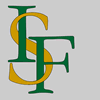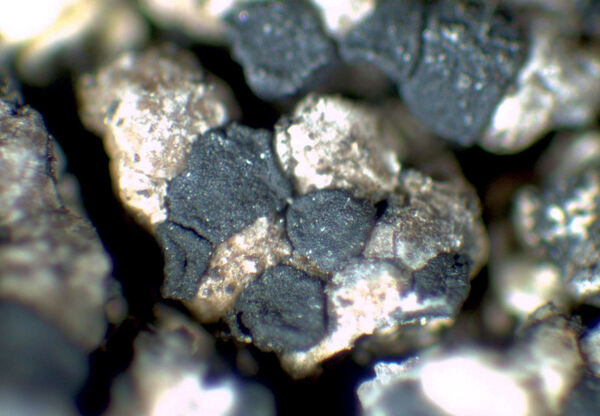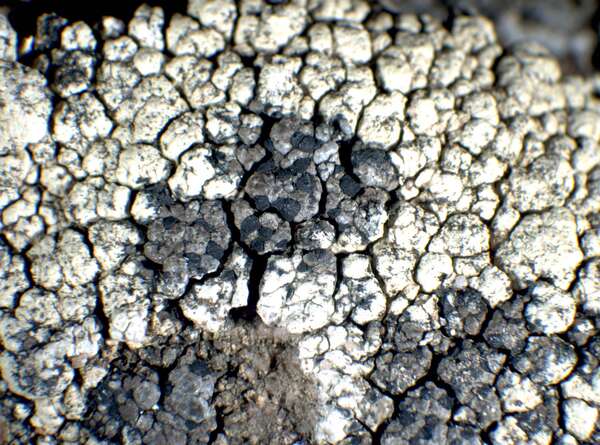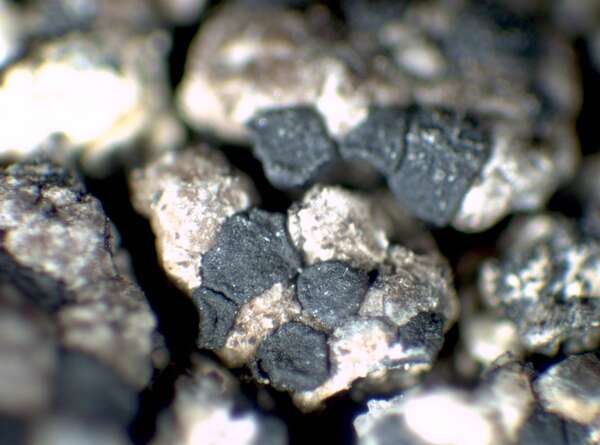Rhizocarpon epispilum (Nyl.) Zahlbr.
Cat. Lich. Univ., 4: 333, 1926. Basionym: Lecidea epispila Nyl. - Bull. Soc. Linn. Normandie, sér. 2, 4: 292, 1872.
Synonyms: Buellia epispila (Nyl.) B. de Lesd.; Rhizocarpon superstratum J. Steiner
Distribution: N - Lig (Giordani & Brunialti 2000). C - Marc (Nimis & Tretiach 1999), Sar (Nöske 2000). S - Bas (Brackel & Puntillo 2023).
Description: Thallus crustose episubstratic, areolate, forming small islands on the thalli of saxicolous Pertusaria-species, often surrounded by a black prothallus reacting I+ blue. Areoles convex, brown, glossy, mostly contiguous. Medulla white, I-. Apothecia lecideine, black, developing between the areoles, 0.2-0.5 mm across, with an initially flat, then often convex disc and a thin, very soon excluded proper margin. Proper exciple of radiating hyphae, brown black and K- in outer part, colourless within, the medullary part of 1-2 µm thick, anastomosing hyphae; epithecium reddish brown, K+ purple-red; hymenium colourless, I+ blue; paraphysoids branched and anastomosing, slender, the apical cells scarcely swollen; hypothecium brown-black, K-. Asci 8-spored, slightly clavate, fissitunicate, with a well-developed tholus that is K/I- in lower part and K/I+ blue near the apex, lacking an ocular chamber, Rhizocarpon-type. Ascospores 1-septate, brown, (16-)19-26(-32) x 9-15(-18) µm, halonate at least when young. Photobiont chlorococcoid. Spot tests: thallus K-, C-, KC-, P-. Chemistry: thallus without lichen substances.Note: on sheltered siliceous rocks wetted by rain, starting the life-cycle on thalli of Pertusaria-species below the montane belt; probably more widespread, but overlooked, throughout Central and Southern Italy.
Growth form: Crustose
Substrata: rocks
Photobiont: green algae other than Trentepohlia
Reproductive strategy: mainly sexual
paras Pertusaria spp.
Commonnes-rarity: (info)
Alpine belt: absent
Subalpine belt: absent
Oromediterranean belt: absent
Montane belt: absent
Submediterranean belt: very rare
Padanian area: absent
Humid submediterranean belt: rare
Humid mediterranean belt: very rare
Dry mediterranean belt: absent

Predictive model
Herbarium samples
Growth form: Crustose
Substrata: rocks
Photobiont: green algae other than Trentepohlia
Reproductive strategy: mainly sexual
paras Pertusaria spp.
Commonnes-rarity: (info)
Alpine belt: absent
Subalpine belt: absent
Oromediterranean belt: absent
Montane belt: absent
Submediterranean belt: very rare
Padanian area: absent
Humid submediterranean belt: rare
Humid mediterranean belt: very rare
Dry mediterranean belt: absent

Predictive model
| Herbarium samples |
 INDEX FUNGORUM
INDEX FUNGORUM
 GBIF
GBIF





